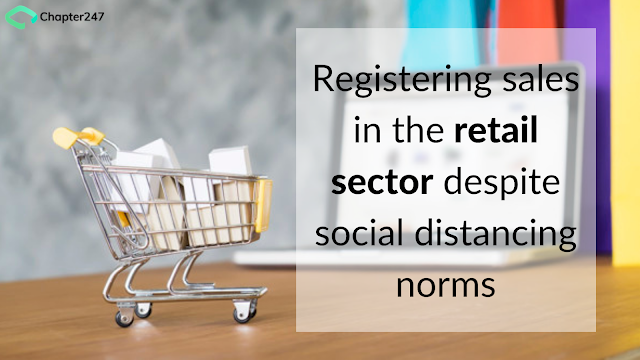Registering sales in the retail sector despite social distancing norms
While the entire situation may create havoc it is also true that it sure has an invisible hand in corrections. Retailers and customers are clueless but it is a fact that the pandemic is activating solutions that might just usher in a new revolution in retail technology. The article sheds light on some of the technologies that need to be adopted to sell while the social distancing norms are on!
Technology that embraces the ‘New Normal’
A survey conducted by YouGov indicated that 85% of internet users in China and a sizable 83% in Hong Kong will avoid crowded places. More than 25% of those in the US and 14% in the UK also said the same thing. If businesses are not pulling insights from such data then it can be too late for them to surpass competition let alone tackle it. Business continuity is the key to survive and the pandemic has forced the retail industry to adopt the new normal and innovate with investment in technologies. These organizations can find viable ways with which they can continue conducting their businesses while maintaining social distancing.
Integrated inventory management
Being in the retail industry for long and if you have not invested in an inventory management software, then it is a grave error. To remove inefficiencies and glitches in inventory management, a sound and long-term investment in inventory management software will go a long way in knowing your warehouse in and out. But if the software is not centralized, that is if it is not integrated with back-office systems and operations, then the software alone will not streamline the inventory. The valid point to note is that shoppers might not have the intention of purchasing everything in their cart. They do it because they fear that the stock will run out. Retailers then face the challenge to regulate and maintain inventory during the crisis.
But amid all this, retailers should focus on investing in a digitally-led omnichannel retail strategy that has a centralized inventory management system to be profitable. The retail organization can provide aa unified experience across the entire customer lifecycle. Real-time solutions will ensure data is at the disposal and will accelerate innovation and automation. Valuable insights can be drawn from how the inventory has to be charged to fulfill demands. With a centralized integrated software, reports can be generated which will provide a sneak peek into what is and what needs to be done.
Digital transformation
Digital Metamorphosis
It was always known that the retail sector would embrace digitalization but the pandemic has accelerated the process. With digitalization, there is a sure shot chance of adding incremental value to the technology solution. These disruptive technologies will help retail enterprises to get a pragmatic perspective of the marketplace. Data will be gathered, filtered, and analyzed to make sense of it. Customers are taking social distancing extremely seriously and are looking at a safe shopping experience with accessibility, uncomplicated interface, and a wide range of products. Retail organizations are also exploring social media to understand the customer psyche. With our Retail technology solutions, organizations can automate their marketing activities and promote their products through the digital medium. Retail analytics also has a large role to play to provide personalized customer engagement strategies across digital marketing channels.
The supply chain will be the important connect meaning that visibility across different digital channels is a must. But with effectively planned solutions, accurate and on-time refilling of stock will happen.
Rapid delivery
Contactless delivery
Even when the customers have ordered they would still be anxious about receiving parcels from delivery persons for the risk it imposes. The need for a contactless delivery program has become a rather urgent scenario for the retail industry.
The global e-commerce sales were predicted to reach $4.2 billion by 2020 but this was before we knew pandemic would happen. But these numbers are an indication of the potential which the retailers should take advantage of. This is where the role of online sales comes in. API makes it convenient to interlock existing businesses with dynamic task-oriented platforms. Software designed will encompass transport management including data such as order number, customer data, and delivery address. With future-ready technology solutions available, users will be able to understand the tasks left to do and what needs to be done. Mobile applications also will allow retailers to track driver locations. They can watch the driver’s location in real-time to ensure that the right package is delivered on time. It is hence important that retailers invest in reliable logistics partners, automate their supply chains, and think innovatively.
Self-service technology
Shoppers can easily scan the items they wish to purchase and pack them too. The self-serve technologies are in the form of a mobile application that can be downloaded onto the personal device of the customer. Customers can avoid any kind of contact by shopping what they need, put the items in their bag, and pay with the online wallets.
Point of Sale
If a customer stands in line waiting to pay the bill, there is a great chance that he or she leaves the line and decides to forgo the purchase. But PoS technology can lead to better waiting line management and therefore will go a long way in reducing resentment. With the help of handheld computers, scanners, and printers with integrated card readers, the point of sale can become fully mobile-application-oriented. Mobile POS terminals can be used throughout the store for contactless payment and faster settling of bills.
It may seem like a forced scenario but when retail organizations will embrace such retail technologies, only then will they be able to tackle competition in its finest forms. It is better to consult retai
l technology solutions providers to unlock the potential and give a major boost to its sales.




Comments
Post a Comment